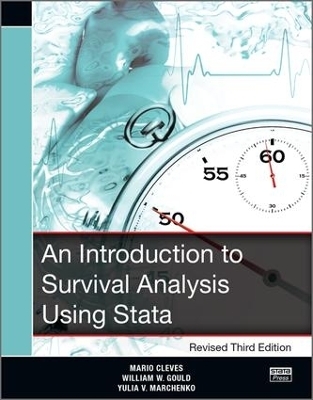
Introduction to Survival Analysis Using Stata
Stata Press (Verlag)
978-1-59718-174-7 (ISBN)
The revised third edition has been updated for Stata 14, and it includes a new section on predictive margins and marginal effects, which demonstrates how to obtain and visualize marginal predictions and marginal effects using the margins and marginsplot commands after survival regression models.
Survival analysis is a field of its own that requires specialized data management and analysis procedures. To meet this requirement, Stata provides the st family of commands for organizing and summarizing survival data.
This book provides statistical theory, step-by-step procedures for analyzing survival data, an in-depth usage guide for Stata's most widely used st commands, and a collection of tips for using Stata to analyze survival data and to present the results. This book develops from first principles the statistical concepts unique to survival data and assumes only a knowledge of basic probability and statistics and a working knowledge of Stata.
The first three chapters of the text cover basic theoretical concepts: hazard functions, cumulative hazard functions, and their interpretations; survivor functions; hazard models; and a comparison of nonparametric, semiparametric, and parametric methodologies. Chapter 4 deals with censoring and truncation. The next three chapters cover the formatting, manipulation, stsetting, and error checking involved in preparing survival data for analysis using Stata's st analysis commands. Chapter 8 covers nonparametric methods, including the Kaplan–Meier and Nelson–Aalen estimators and the various nonparametric tests for the equality of survival experience.
Chapters 9–11 discuss Cox regression and include various examples of fitting a Cox model, obtaining predictions, interpreting results, building models, model diagnostics, and regression with survey data. The next four chapters cover parametric models, which are fit using Stata's streg command. These chapters include detailed derivations of all six parametric models currently supported in Stata and methods for determining which model is appropriate, as well as information on stratification, obtaining predictions, and advanced topics such as frailty models. Chapter 16 is devoted to power and sample-size calculations for survival studies. The final chapter covers survival analysis in the presence of competing risks.
Mario Cleves is Professor and the Biostatistics Section Chief in the Department of Pediatrics at the University of Arkansas for Medical Sciences.
William Gould is the president and head of development at StataCorp.
Yulia Marchenko is a senior statistician at StataCorp. All are authors of Stata statistical software, in particular, Stata's widely used survival analysis suite.
List of tables
List of figures
Preface to the Revised Third Edition
Preface to the Third Edition
Preface to the Second Edition
Preface to the Revised Edition
Preface to the First Edition
Notation and typography
1 The problem of survival analysis
1.1 Parametric modeling
1.2 Semiparametric modeling
1.3 Nonparametric analysis
1.4 Linking the three approaches
2 Describing the distribution of failure times
2.1 The survivor and hazard functions
2.2 The quantile function
2.3 Interpreting the cumulative hazard and hazard rate
2.3.1 Interpreting the cumulative hazard
2.3.2 Interpreting the hazard rate
2.4 Means and medians
3 Hazard models
3.1 Parametric models
3.2 Semiparametric models
3.3 Analysis time (time at risk)
4 Censoring and truncation
4.1 Censoring
4.1.1 Right-censoring
4.1.2 Interval-censoring
4.1.3 Left-censoring
4.2 Truncation
4.2.1 Left-truncation (delayed entry)
4.2.2 Right-truncation
4.2.3 Gaps
5 Recording survival data
5.1 The desired format
5.2 Other formats
5.3 Example: Wide-form snapshot data
6 Using stset
6.1 A short lesson on dates
6.2 Purposes of the stset command
6.3 Syntax of the stset command
6.3.1 Specifying analysis time
6.3.2 Variables defined by stset
6.3.3 Specifying what constitutes failure
6.3.4 Specifying when subjects exit from the analysis
6.3.5 Specifying when subjects enter the analysis
6.3.6 Specifying the subject-ID variable
6.3.7 Specifying the begin-of-span variable
6.3.8 Convenience options
7 After stset
7.1 Look at stset’s output
7.2 List some of your data
7.3 Use stdescribe
7.4 Use stvary
7.5 Perhaps use stfill
7.6 Example: Hip-fracture data
8 Nonparametric analysis
8.1 Inadequacies of standard univariate methods
8.2 The Kaplan–Meier estimator
8.2.1 Calculation
8.2.2 Censoring
8.2.3 Left-truncation (delayed entry)
8.2.4 Gaps
8.2.5 Relationship to the empirical distribution function
8.2.6 Other uses of sts list
8.2.7 Graphing the Kaplan–Meier estimate
8.3 The Nelson–Aalen estimator
8.4 Estimating the hazard function
8.5 Estimating mean and median survival times
8.6 Tests of hypothesis
8.6.1 The log-rank test
8.6.2 The Wilcoxon test
8.6.3 Other tests
8.6.4 Stratified tests
9 The Cox proportional hazards model
9.1 Using stcox
9.1.1 The Cox model has no intercept
9.1.2 Interpreting coefficients
9.1.3 The effect of units on coefficients
9.1.4 Estimating the baseline cumulative hazard and survivor functions
9.1.5 Estimating the baseline hazard function
9.1.6 The effect of units on the baseline functions
9.2 Likelihood calculations
9.2.1 No tied failures
9.2.2 Tied failures
The marginal calculation
The partial calculation
The Breslow approximation
The Efron approximation
9.2.3 Summary
9.3 Stratified analysis
9.3.1 Obtaining coefficient estimates
9.3.2 Obtaining estimates of baseline functions
9.4 Cox models with shared frailty
9.4.1 Parameter estimation
9.4.2 Obtaining estimates of baseline functions
9.5 Cox models with survey data
9.5.1 Declaring survey characteristics
9.5.2 Fitting a Cox model with survey data
9.5.3 Some caveats of analyzing survival data from complex survey designs
9.6 Cox model with missing data—multiple imputation
9.6.1 Imputing missing values
9.6.2 Multiple-imputation inference
10 Model building using stcox
10.1 Indicator variables
10.2 Categorical variables
10.3 Continuous variables
10.3.1 Fractional polynomials
10.4 Interactions
10.5 Time-varying variables
10.5.1 Using stcox, tvc() texp()
10.5.2 Using stsplit
10.6 Modeling group effects: fixed-effects, random-effects, stratification, and clustering
11 The Cox model: Diagnostics
11.1 Testing the proportional-hazards assumption
11.1.1 Tests based on reestimation
11.1.2 Test based on Schoenfeld residuals
11.1.3 Graphical methods
11.2 Residuals and diagnostic measures
Reye’s syndrome data
11.2.1 Determining functional form
11.2.2 Goodness of fit
11.2.3 Outliers and influential points
12 Parametric models
12.1 Motivation
12.2 Classes of parametric models
12.2.1 Parametric proportional hazards models
12.2.2 Accelerated failure-time models
12.2.3 Comparing the two parameterizations
13 A survey of parametric regression models in Stata
13.1 The exponential model
13.1.1 Exponential regression in the PH metric
13.1.2 Exponential regression in the AFT metric
13.2 Weibull regression
13.2.1 Weibull regression in the PH metric
Fitting null models
13.2.2 Weibull regression in the AFT metric
13.3 Gompertz regression (PH metric)
13.4 Lognormal regression (AFT metric)
13.5 Loglogistic regression (AFT metric)
13.6 Generalized gamma regression (AFT metric)
13.7 Choosing among parametric models
13.7.1 Nested models
13.7.2 Nonnested models
14 Postestimation commands for parametric models
14.1 Use of predict after streg
14.1.1 Predicting the time of failure
14.1.2 Predicting the hazard and related functions
14.1.3 Calculating residuals
14.2 Using stcurve
14.3 Predictive margins and marginal effects
14.3.1 Predictive margins
Marginal mean survival time
Marginal survival probabilities
Multiple-record data
14.3.2 Marginal effects
15 Generalizing the parametric regression model
15.0.3 Using the ancillary() option
15.0.4 Stratified models
15.1 Frailty models
15.1.1 Unshared-frailty models
15.1.2 Example: Kidney data
15.1.3 Testing for heterogeneity
15.1.4 Shared-frailty models
16 Power and sample-size determination for survival analysis
16.1 Estimating sample size
16.1.1 Multiple-myeloma data
16.1.2 Comparing two survivor functions nonparametrically
16.1.3 Comparing two exponential survivor functions
16.1.4 Cox regression models
16.2 Accounting for withdrawal and accrual of subjects
16.2.1 The effect of withdrawal or loss to follow-up
16.2.2 The effect of accrual
16.2.3 Examples
16.3 Estimating power and effect size
16.4 Tabulating or graphing results
17 Competing risks
17.1 Cause-specific hazards
17.2 Cumulative incidence functions
17.3 Nonparametric analysis
17.3.1 Breast cancer data
17.3.2 Cause-specific hazards
17.3.3 Cumulative incidence functions
17.4 Semiparametric analysis
17.4.1 Cause-specific hazards
Simultaneous regressions for cause-specific hazards
17.4.2 Cumulative incidence functions
Using stcrreg
Using stcox
17.5 Parametric analysis
References
Author index
Subject index
| Erscheinungsdatum | 12.07.2016 |
|---|---|
| Verlagsort | College Station |
| Sprache | englisch |
| Maße | 187 x 235 mm |
| Gewicht | 907 g |
| Einbandart | kartoniert |
| Themenwelt | Geisteswissenschaften ► Psychologie ► Statistik / Evaluation |
| Informatik ► Datenbanken ► Data Warehouse / Data Mining | |
| Mathematik / Informatik ► Informatik ► Software Entwicklung | |
| Informatik ► Weitere Themen ► Bioinformatik | |
| Mathematik / Informatik ► Mathematik ► Computerprogramme / Computeralgebra | |
| Mathematik / Informatik ► Mathematik ► Statistik | |
| Naturwissenschaften ► Biologie ► Ökologie / Naturschutz | |
| Wirtschaft ► Volkswirtschaftslehre ► Ökonometrie | |
| Schlagworte | Biostatistische Überlebensanalyse • Cox-Regressionsanalyse • Ereignisdatenanalyse • Event History Analysis • Hazardrate • product-limit Kaplan-Meier estimator • Survival-Analyse • Survival Analysis • Überlebensanalyse • Verweildaueranalyse |
| ISBN-10 | 1-59718-174-9 / 1597181749 |
| ISBN-13 | 978-1-59718-174-7 / 9781597181747 |
| Zustand | Neuware |
| Informationen gemäß Produktsicherheitsverordnung (GPSR) | |
| Haben Sie eine Frage zum Produkt? |
aus dem Bereich


